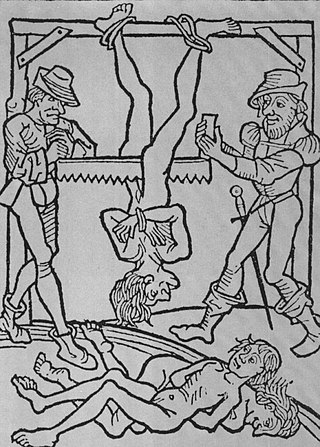Related Research Articles

Decapitation is the total separation of the head from the body. Such an injury is inevitably fatal to humans and most other animals, since it deprives the brain of oxygenated blood, while all other organs are deprived of the involuntary functions that are needed for the body to function.

The breaking wheel was a torture method used for public execution primarily in Europe from antiquity through the Middle Ages into the early modern period by breaking the bones of a criminal or bludgeoning them to death. The practice was abolished in Bavaria in 1813 and in the Electorate of Hesse in 1836: the last known execution by the "Wheel" took place in Prussia in 1841. In the Holy Roman Empire it was a "mirror punishment" for highwaymen and street thieves, and was set out in the Sachsenspiegel for murder, and arson that resulted in fatalities.

Disembowelment, evisceration or gutting is the removal of some or all of the organs of the gastrointestinal tract, usually through an incision made across the abdominal area. Evisceration is a routine operation during animal slaughter. In ancient Rome, disembowelment of animals was practiced for divination, and was known as haruspicy. Disembowelment of humans may result from an accident, but has also been used as a method of torture, execution, or suicide. In such practices, disembowelment may be accompanied by various forms of torture or the removal of other vital organs.

Hamida Djandoubi was a Tunisian convicted murderer sentenced to death in France. He moved to Marseille in 1968, and six years later he kidnapped, tortured, and murdered 22-year-old Élisabeth Bousquet. He was sentenced to death in February 1977 and executed by guillotine in September that year. He was the last person to be executed in Western Europe, and also the last person to be lawfully executed by beheading anywhere in the Western world, although he was not the last person sentenced to death in France. Marcel Chevalier served as chief executioner.

The iron maiden is a mythical torture device, consisting of a solid iron cabinet with a hinged front and spike-covered interior, sufficiently tall to enclose a human being. The first stories citing the iron maiden were composed in the 19th century. The use of iron maidens is considered to be a myth, heightened by the belief that people of the Middle Ages were uncivilized; evidence of their actual use is difficult to find. They have become a popular image in media involving the Middle Ages and involving torture chambers.

Death by sawing is the act of sawing or cutting a living person in half, either sagittally, or transversely.

Carl Ritter was a German geographer. Along with Alexander von Humboldt, he is considered one of the founders of modern geography. From 1825 until his death, he occupied the first chair in geography at the University of Berlin.

Premature burial, also known as live burial, burial alive, or vivisepulture, means to be buried while still alive.

The term Kaiserpfalz or Königspfalz refers to a number of castles and palaces across the Holy Roman Empire that served as temporary, secondary seats of power for the Holy Roman Emperor in the Early and High Middle Ages. The term was also used more rarely for a bishop who, as a territorial lord (Landesherr), had to provide the king and his entourage with board and lodging, a duty referred to as Gastungspflicht.

Michael Sattler was a monk who left the Roman Catholic Church during the Protestant Reformation to become one of the early leaders of the Anabaptist movement. He was particularly influential for his role in developing the Schleitheim Confession.

Mainz Hauptbahnhof is a railway station for the city of Mainz in the German state of Rhineland-Palatinate. It is used by about 60,000 travelers and visitors each day and is therefore by far the busiest station in Rhineland-Palatinate. The station was a trial area for a CCTV scheme using automated face recognition.
Capital punishment is forbidden in Switzerland by article 10, paragraph 1 of the Swiss Federal Constitution. Capital punishment was abolished from federal criminal law in 1942, but remained available in military criminal law until 1992. The last actual executions in Switzerland took place during World War II.

The Lübeck Martyrs were three Roman Catholic priests – Johannes Prassek, Eduard Müller and Hermann Lange – and the Evangelical-Lutheran pastor Karl Friedrich Stellbrink. All four were executed by beheading on 10 November 1943 less than 3 minutes apart from each other at Hamburg's Holstenglacis Prison. Eyewitnesses reported that the blood of the four clergymen literally ran together on the guillotine and on the floor. This impressed contemporaries as a symbol of the ecumenical character of the men's work and witness. That interpretation is supported by their last letters from prison, and statements they themselves made during their time of suffering, torture and imprisonment. "We are like brothers," Hermann Lange said.
Elizabeth of Doberschütz, née von Strantz was beheaded as a witch on the Hay Market in Stettin and burned on the outskirts of the city

The Frankfurt University Library is the library for the Goethe University Frankfurt, Germany.
Franz Friedrich Carl Gröpler was Royal Prussian executioner from 1906 to 1937. Responsible for carrying out capital punishment in the Prussian provinces, he executed at least 144 people, primarily by beheading with an axe, but also with guillotines. Gröpler was one of the most famous executioners in Germany.

The terms landwehr, landgraben and landhege refer to border demarcations or border defences and enclosures in Central Europe that were either built by settlements with the right of enclosure or to mark and defend entire territories. These measures, usually comprising earthworks or dykes as well as ditches and impenetrable lines of hedging, for protecting towns and villages date mainly to the High and Late Middle Ages and consist, in some cases, of systems over a hundred kilometres long. Comparable earthworks have been recorded since Antiquity. The Roman limes are the best known examples of earlier landwehrs. The Danewerk is another example of this type of barrier.

Alte Brücke is a bridge in Frankfurt, Hesse, Germany. It is the oldest bridge over the lower course of the river Main, and until 1886 was the only stone bridge crossing the river. From the Middle Ages until the year 1914, it connected the "Fahrgasse" in Frankfurt Altstadt with the "Brückenstraße" in Sachsenhausen. Since its first mention in official documents in 1222, the development of Frankfurt has been strongly influenced by the bridge. Over the centuries, Alte Brücke has been destroyed and reconstructed at least 18 times. With its 13 brick-built circular arches, the Sachsenhausen Bridge was one of the most prominent buildings of the city, but failing to meet the increasing demands of the modern road and ship traffic, it was demolished in 1914.

The fortifications of Frankfurt were a system of military defences of the German city of Frankfurt am Main which existed from the Middle Ages into the 19th century. Around 1000 the first city wall was built. It enclosed the area of what is now the Königspfalz in modern Frankfurt. In the twelfth century the settlement expanded into what is now Altstadt. For its protection an additional wall, the Staufenmauer, was erected. Starting in 1333, the Neustadt suburb developed north of the Altstadt and was encompassed by an additional wall with five gates. In the fifteenth century, a "landwehr border" was created around the entire territory of the Free City of Frankfurt. Beginning in 1628, the medieval city wall was developed to form a bastion fortress under the municipal architect Johann Dilich.

Dr. Johann Georg Albrecht (1629–1703) served in the office of Legal Counsel to the Imperial Free City of Rothenburg ob der Tauber for 49 years (1654–1703). He was a member of the patrician Albrechts of Rothenburg ob der Tauber, many of whose members served in administrative capacities in that city during the second half of the Holy Roman Empire.
References
- ↑ Jacobsen (2008), p.127
- ↑ Felix Carey - 'a colourful and tragic life'
- ↑ Carey (1815), p.66
- ↑ Rohman (2005), p.62
- ↑ Falarti (2012), p.93, footnote 26
- ↑ Feldman (2008), p.72 The practice of politically motivated fratricide lasted principally from 1451-1648, only to be used once again, in 1808. See Quataert (2005), p.92
- ↑ Frazer (2012), p.243
- ↑ Rublack (1999), p.81
- ↑ von Winterbach (1826), p.198-199
- ↑ Welch (2013), p.38 A curious parallel had happened in Nuremberg 70 years before, in 1513. A female thief had been condemned to be buried alive, but the woman became so hysterical that she scratched the skin off her arms. The executioner at that time, Deipold, managed to convince the city authorities, that thereafter female thieves should merely be drowned, rather than buried alive. The city authorities formally decreed this in conjunction with the next woman to be executed for theft, in 1515. Siebenkees (1792), p.599
- ↑ Battonn, Euler (1861), p.223
- ↑ Chladenius (1788), p.97
- ↑ Fritsch (1828), p.41
- ↑ Chambers (1870), p.676 In the canton of Zürich, the last case of drowning was in 1615. von Knonau (1846), p.335
- ↑ Chambers (1870), p.676
- ↑ ISIS Video Shows Jihadists Drowning Caged Prisoners in Swimming Pool; New Invasion of Kobane Kills 50